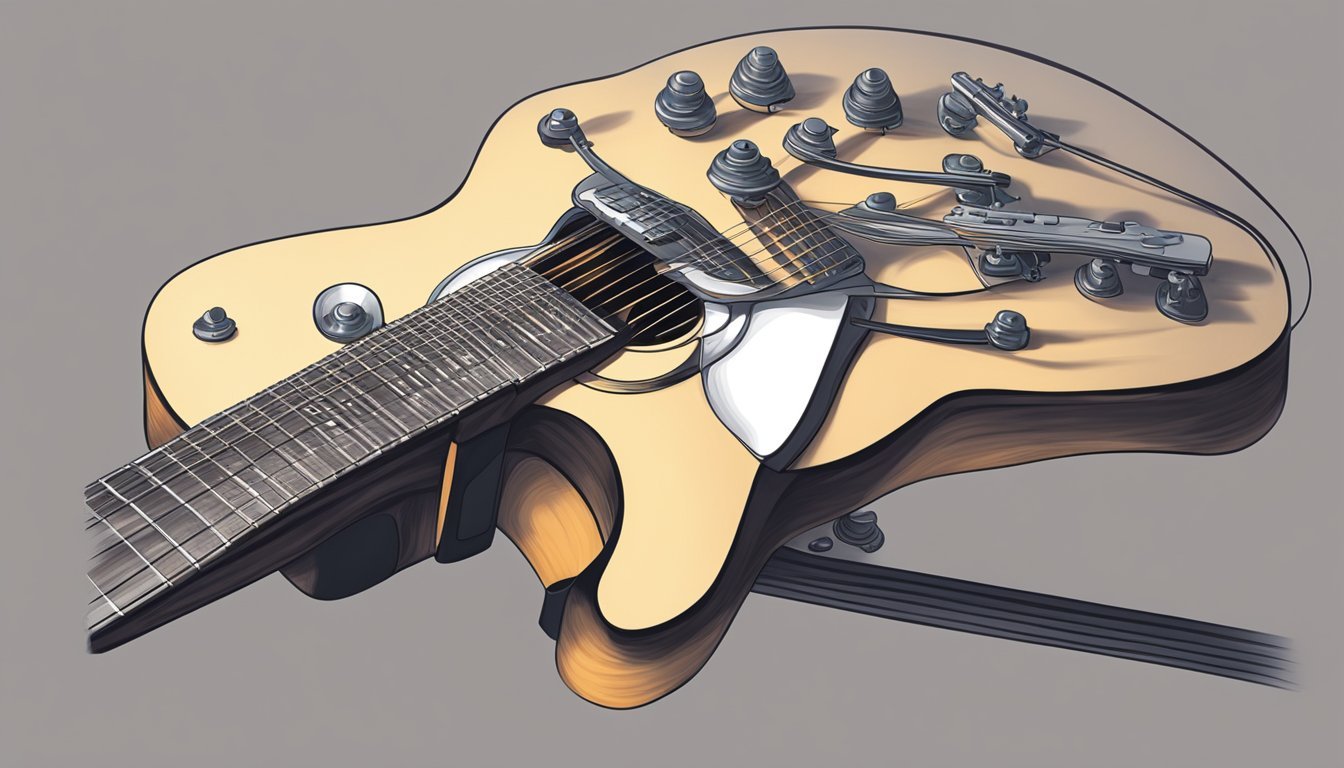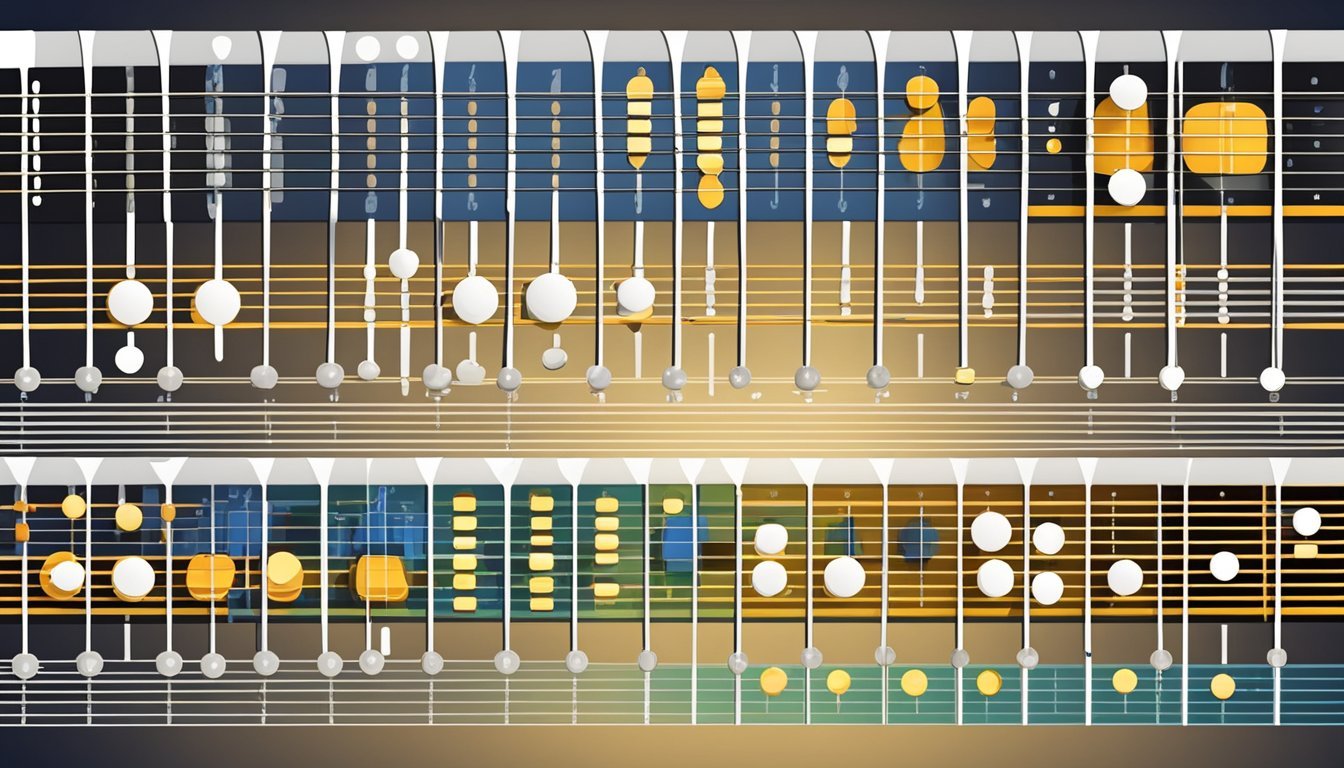If you’re new to playing guitar, understanding chords is key to making music.
Guitar chords are combinations of notes played together, creating the foundation for songs and melodies.
With a few basic shapes, you can quickly start playing popular tunes and express yourself through music.

As you dive into the world of guitar, you’ll discover different types of chords, from simple open chords to more complex variations. Learning to change chords smoothly will help you play more fluidly.
Plus, practicing common chord shapes can speed up your progress as a beginner.
Getting a grip on chords opens up endless possibilities for your musical journey.
As you explore different techniques and tips, you’ll find that mastering guitar chords is both fun and rewarding.
Key Takeaways
- Learning basic guitar chords is essential for beginners.
- Practicing chord shapes helps improve your playing skills.
- Understanding advanced chords expands your musical options.
Basic Guitar Chords for Beginners
Learning the basic guitar chords is key to starting your music journey.
You’ll get familiar with chord diagrams and understand essential major and minor chords.
This knowledge will help you strum along to many songs quickly.
Understanding Chord Diagrams
Chord diagrams are visual guides showing you how to play chords.
They represent the guitar neck from the player’s viewpoint.
The vertical lines indicate the strings, while the horizontal lines show the frets.
Dots on the diagram indicate where to place your fingers.
Here’s a simple breakdown:
- Numbers at the bottom of the diagram refer to your fingers: 1=index, 2=middle, 3=ring, 4=pinky.
- An “X” means that string should not be played.
- An “O” shows that string is played open.
Using these diagrams helps you practice effectively.
Major and Minor Chords
Major and minor chords are the building blocks of music.
They create different emotional feelings in songs.
-
Major Chords have a happy sound. For example, the C Major chord consists of the notes C, E, and G. The G Major chord uses the notes G, B, and D.
-
Minor Chords sound more somber. For example, the A Minor chord includes A, C, and E. The E Minor chord consists of E, G, and B.
Knowing these chords will enhance your playing and expand your song choices.
Simple Open Chords
Open chords are the best starting point for beginners.
These chords allow you to play with at least one open string, making it easier to sound out.
Here are some common open chords:
- C Major: Place your fingers on the 1st fret of the 2nd string, 2nd fret of the 4th string, and 3rd fret of the 5th string. Mute string 6.
- D Major: Place your index finger on the 2nd fret of the 3rd string, middle finger on the 2nd fret of the 1st string, and ring finger on the 3rd fret of the 2nd string.
- G Major: This chord uses your 2nd finger on the 3rd fret of the 6th string. Your 1st finger goes on the 2nd fret of the 5th string and your other fingers on the 3rd fret of 1st, 2nd, and 3rd strings.
Practicing these chords will help you quickly play many songs.
Advanced Chord Types and Their Construction

When you dive deeper into guitar playing, you’ll come across several advanced chord types that can enhance your sound.
Understanding barre chords, 7th chords, and jazz chords will give you more options for playing and expressing yourself musically.
Barre Chords and Power Chords
Barre chords are a powerful tool for guitarists.
They let you play the same chord shape across different frets, which allows you to change keys easily.
Essentially, you use your index finger to press down multiple strings at once.
For example, the E minor shape moved up a fret becomes an F minor chord.
Power chords, on the other hand, are simpler.
They include just the root note and the fifth, giving a punchy sound often heard in rock music.
To play a power chord, you only need two or three fingers.
For instance, playing a G power chord uses the notes G and D.
7th Chords and Their Variations
7th chords add depth and texture to your music.
These chords include a seventh note along with the basic triad.
You have different types:
- Major 7th: Adds a major seventh note.
- Minor 7th: Contains a minor seventh note.
- Dominant 7th: Has a major triad plus a minor seventh.
Each type has its own unique sound.
For example, a C major 7th chord will have a dreamy quality, while a C dominant 7th creates tension, which resolves well to other chords.
You can mix these chords into your progressions for a richer sound.
Jazz Chords and Extended Harmonies
Jazz guitar chords bring a world of complex sounds.
They often use extended harmonies, which add notes beyond the basic triad or seventh.
Common extensions include the 9th, 11th, and 13th.
For instance, a D9 chord not only includes the root, third, and seventh but also the ninth.
Other interesting chords are diminished chords, which add a unique tension to your playing.
Jazz chords are often voiced differently, meaning you can rearrange the order of notes for a fresh sound.
This creativity makes jazz guitar chords exciting to use in various musical styles.
Techniques for Playing and Changing Chords
Mastering chord changes on the guitar involves knowing how to position your fingers correctly, how to pick and strum effectively, and how to use tools like a capo.
Each of these techniques can help you play smoothly and sound great.
Proper Finger Placements
Getting your finger placements right is essential for clean chord sounds.
When you form a chord, make sure your fingertips press down on the strings without touching others.
This helps avoid muted or buzzing sounds.
For example, in an E minor chord, your second and third fingers go to the second fret of the A and D strings.
Keep your fingers curved so they don’t touch adjacent strings.
Practice placing your fingers and lifting them quickly to switch between chords.
Try to minimize movement so you can change chords more efficiently.
Picking and Strumming Chords
Knowing how to pick and strum will greatly enhance your playing.
Start by using a pick for clarity.
Hold it between your thumb and index finger.
Use your wrist to move it down across the strings.
For strumming, experiment with different patterns.
You might start with downstrokes, then mix in some upstrokes.
This adds rhythm and style to your playing.
It’s crucial to keep a steady tempo.
You can practice with a metronome or a drumbeat to build your timing.
Aim to focus on strumming all the strings evenly for rich chord sound.
Using a Capo for Easier Transitions
A capo can make changing chords much easier, especially when you’re starting out.
By placing it on a fret, you essentially raise the pitch of the guitar.
This allows you to play in different keys without learning new chord shapes.
For instance, if you struggle with a G chord, place the capo on the second fret to play an A chord instead.
Make sure to clamp the capo tightly without bending the strings. Experiment with different positions to find what sounds best for your song.
A capo can open up new possibilities and make playing more enjoyable.
Practical Tips for Learning Guitar Chords
Learning guitar chords can be fun and rewarding.
By focusing on practice routines, transitions, and applying chords to songs, you can improve your skills quickly.
Here are some practical tips to guide you.
Practice Routines and Exercises
Creating a practice routine helps build your skills steadily.
Start with easy guitar chords like C, G, and D. Spend 10 minutes each day working on these.
Try the following exercises:
- Chord shapes: Visualize the chord shapes before playing. This helps build muscle memory.
- Strumming patterns: Experiment with different strumming. Try downstrokes only, then mix in upstrokes.
- Arpeggios: Play chords one note at a time. This technique enhances finger control and lets you hear each note.
You can use a chord finder app or resources to locate shapes and variations.
Remember to set small goals for each session.
For example, aim to switch between two chords smoothly.
Chord Transition Techniques
Chord transitions can be tricky at first, so focus on moving between chords with minimal hand movement.
Here are some techniques to help you:
- Anchor fingers: Keep one or two fingers in place while moving the others. For example, when switching from C to G, your 1st finger can stay down longer.
- Practice slow: Move through transitions slowly, and increase your speed as you get comfortable. This helps solidify the movement in your memory.
- Use a metronome: Start at a slow tempo, then gradually speed up. This trains your timing and helps you maintain a steady rhythm.
Practice transitioning frequently until it feels natural.
With time, you’ll notice improvements in your chord changes.
Learning Songs to Apply Chords
Applying what you’ve learned by playing songs keeps things exciting.
Start with beginner guitar songs that use easy chords.
Here are some popular options:
- “Knockin’ on Heaven’s Door” (G, D, A)
- “Sweet Home Alabama” (D, C, G)
- “Horse with No Name” (Em, D6add9)
Pick a song and break it into sections.
Learn one part before moving to the next.
Pay attention to chord changes in the song.
This not only improves your chord skills but also helps you understand chord theory through real music.
Once you’re comfortable, try playing along with recordings or backing tracks.
Enjoy the process, and you’ll feel more confident over time!
Frequently Asked Questions
Learning guitar chords can seem tricky at first, but it gets easier with practice.
Here are some common questions you might have as you start your guitar journey.
As you familiarize yourself with the basic chords, you’ll discover that consistency is key to improvement.
Many beginners often wonder how to play great thou art, a beloved hymn that can serve as a perfect practice piece.
With time and dedication, you’ll not only learn the chords but also develop the muscle memory needed to transition smoothly between them.
What’s the starting point for learning guitar chords as a beginner?
Begin by learning a few basic chords.
Start with major chords like C, G, and D. These are often used in many songs and help you get familiar with finger placement.
Can you give me an easy chart of guitar chords to look at?
You can find charts online that show you the finger placements for each chord.
A simple chart usually highlights major and minor chords, making it easier for you to see where to put your fingers.
How do I go about reading guitar chords tabs?
Guitar tabs show you where to place your fingers on the fretboard.
Numbers tell you which fret to press on each string.
For example, a “0” means to play the string open, and “1” means to press it on the first fret.
What are some simple guitar chord-based songs for a newbie?
Great beginner songs include “Knockin’ on Heaven’s Door” and “Three Little Birds.” Both of these use simple chords, so you can practice your playing while enjoying some music.
What are the essential chords I should learn on a 6-string guitar?
Start with these essential chords: C, G, D, A, E, Am, and Em.
These chords will help you play a wide variety of songs.
Mastering them will build your confidence as a player.
How to get a grip on guitar chord structure
Guitar chords are built from root notes, thirds, and fifths.
Understanding these parts can help you recognize how different chords are formed.
This knowledge will also help you start creating your own chords over time.

